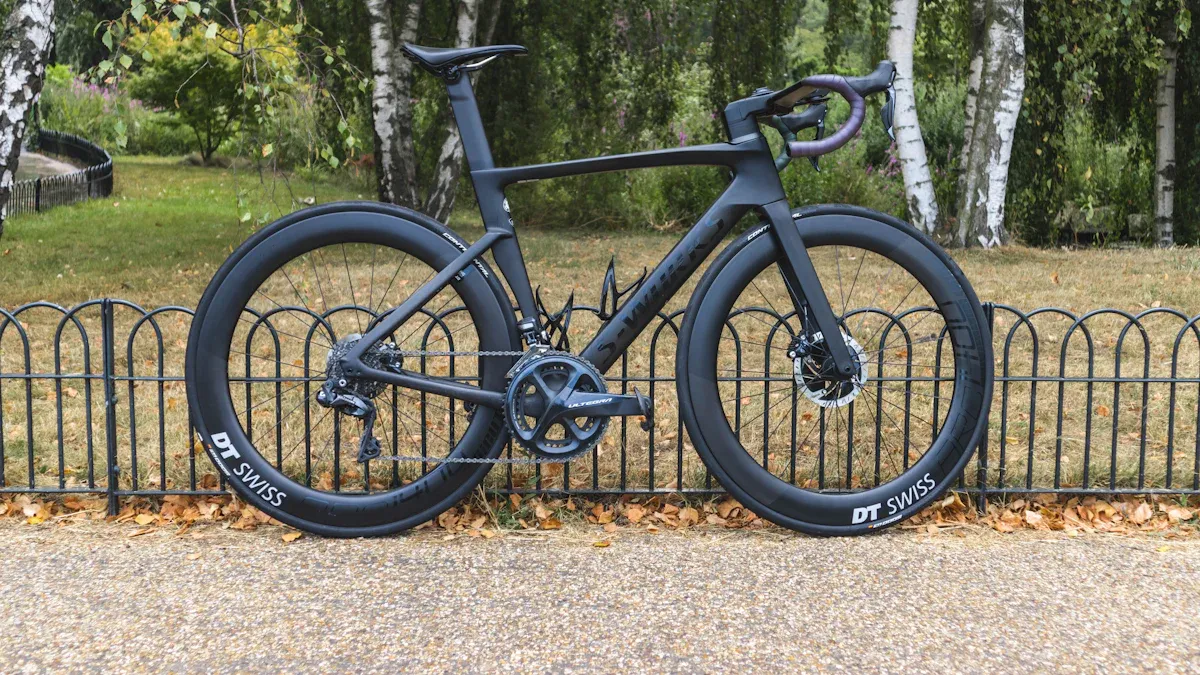
Have you ever wondered why choosing the right bike size matters? Getting the right bike size can greatly enhance your comfort and performance on the road. A well-fitted bike allows you to ride longer and enjoy the journey. Several factors come into play when selecting your ideal bike, such as body geometry, riding style, and key measurements like leg inseam and seat tube length. Let’s explore how you can find the perfect medium size frame road bike tailored just for you!
Key Takeaways
Picking the right frame size is very important for comfort and how well you ride. A medium frame usually fits people from 5’3″ to 5’8″.
How a bike fits you is more important than size charts. Always think about how the bike feels instead of what the chart says.
It is important to measure your height and inseam correctly. Use these measurements to find the best frame size for you.
The shape of the frame can change how you ride. Think about if you want speed, comfort, or stability when choosing a bike.
Different frame materials have special benefits. Carbon fiber is light and strong, while aluminum is cheaper and lasts longer.
Frame Size Basics

Choosing a medium size frame road bike is very important. The right frame size can change how you ride. It connects to your height, so you need to pay attention to this.
Medium Size Frame Road Bike
Most bike makers say medium size frame road bikes fit riders from 5’3″ to 5’8″. This range helps you reach the handlebars and pedals easily. Here’s a quick table to help you see this:
Height Range | Frame Size |
|---|---|
5’3″ – 5’8″ | Medium (M) |
How do you measure a bike frame? Frame size is usually measured from the bottom bracket to the top of the seat tube. This measurement is very important because it shows how well the bike fits you. For example, a seat tube length of 51cm might be called a small frame by some brands, but others may call it medium. This shows why you should check the sizing chart for each brand.
Different brands use different measurements for medium size frame road bikes. These include effective top tube length, chainstay length, and wheelbase. Each of these affects how the bike rides. For example, the effective top tube length changes your posture. The chainstay length and wheelbase help with stability. If you want speed, you might like a bike with race geometry for better aerodynamics. If comfort is more important, an endurance geometry bike could be the best choice.
Road Bike Sizing Chart
When it comes to finding the right bike, a sizing chart can be your best friend. It helps you match your height and leg inseam to the appropriate bike frame size. Here’s a standard road bike sizing chart to guide you:
Rider Height | Leg Inseam | Suggested Frame Size |
|---|---|---|
5′ 6″ – 5′ 9″ | 30” (76cm) | M |
5′ 9″ – 6′ 0″ | 31” (79cm) | L |
This chart gives you a good starting point, but remember, it’s just a guideline.
Tip: Always compare your leg inseam to the suggested road bike size. Proper measurements of your height and inseam are essential for determining the right bike frame size.
Why is leg inseam so important? Well, manufacturers often provide sizing recommendations based on inseam length. Matching your bike frame size to your leg length enhances pedaling efficiency. If you’re a beginner, using inseam measurements to select your bike size is a practical starting point.
Here’s another look at how inseam measurements relate to frame sizes:
Size | Height | Inseam |
|---|---|---|
54 | 168.0 – 174.0 cm | 78.0 – 82.0 cm |
56 | 174.0 – 180.0 cm | 81.0 – 85.0 cm |
By checking these measurements, you can ensure a comfortable ride. A well-fitted bike allows you to pedal smoothly and maintain control. So, take your time measuring and comparing. You’ll thank yourself later when you hit the road with confidence!
Choosing the Right Frame Size
Frame Shape Considerations
When you’re choosing the right frame size, personal fit is more important than any manufacturer chart. While charts provide a good starting point, they can’t account for your unique body shape and riding style. Many cyclists, even professionals, often choose smaller frames. This choice can lead to discomfort and performance issues. Smaller frames might feel cozy, but they can restrict your movement and efficiency.
Tip: Always prioritize how a bike feels over what the sizing chart suggests. A proper bike fitting session can help you find the best fit for your body.
To get the most accurate bike fitting, you should measure your height and inseam correctly. Here’s how to do it:
Stand straight against a wall: Make sure your heels are touching the wall.
Use a flat object: Place it on your head, making sure it’s level. Mark where it touches the wall.
Measure the distance: Use a tape measure from the floor to the mark on the wall. This is your height.
Measure your inseam: Stand with your feet shoulder-width apart. Measure from the ground to your crotch. This is your inseam.
Make sure to wear cycling shoes when you measure your inseam. They can affect your leg length. Aim for about 1 inch of clearance for traditional top tubes and 2 inches or more for sloping top tubes. This ensures you can straddle the bike comfortably.
Here’s a handy table to help you estimate your frame size based on inseam and height:
Inseam (cm) | Height (cm) | Frame Size (cm) |
|---|---|---|
64 – 67 | 140 – 150 | 45 – 46 |
67 – 71 | 144 – 157 | 47 – 49 |
71 – 74 | 153 – 166 | 50 – 52 |
74 – 78 | 162 – 174 | 53 – 54 |
78 – 82 | 170 – 183 | 55 – 57 |
82 – 85 | 178 – 188 | 58 – 59 |
85 – 89 | 184 – 198 | 60 – 62 |
89 – 93 | 193 – 205 | 63 – 64 |
93+ | 199+ | 65 – 67 |
Using this table, you can get a clearer idea of what frame size might work for you. Remember, the goal is to achieve a healthy pedal stroke. If your bike doesn’t fit right, you won’t ride right, and that can lead to injuries or discomfort over time.
Frame Geometry and Riding Style

When you think about frame geometry, think of it as your bike’s plan. It includes sizes like head tube angle, chainstay length, and wheelbase. These things affect how your bike rides and performs on the road. For example, a bike with a shorter trail is quicker and easier to turn. On the other hand, a longer trail gives you more stability, especially when going fast. So, if you want a bike that feels quick in tight turns, you might like one with a steeper head tube angle.
Here’s a quick look at how different shapes can match your riding goals:
Performance Frames: These frames are made for speed. They have a low, stretched-out position that cuts down wind drag. If you like racing or fast group rides, this shape helps you use your power better.
All-Rounder Frames: These frames mix comfort and performance. They work well for many riding styles, from commuting to weekend trips. If you want flexibility, this is a good choice.
Touring Frames: If you plan to go on long rides with gear, look for a touring frame. These bikes have a relaxed shape that helps you sit up straight, making long rides more comfortable. They also have longer wheelbases for stability on bumpy roads.
To find the right fit, think about your riding style. Do you want to race, tour, or just enjoy easy rides? Each style has its best frame shape. For example, touring bikes usually have a slack head tube angle for steady steering and long chainstays to keep your gear safe.
Frame Materials Overview
When you pick a road bike frame, the material matters a lot. It can change how you ride. Here are some common materials for medium size road bike frames:
Steel
Chromoly Steel
Aluminum
Titanium
Carbon Fiber
Each material has good and bad points. Let’s look at the two most popular types: carbon and aluminum.
Carbon Fiber vs. Aluminum
Aspect | Carbon Frame | Aluminum Frame |
|---|---|---|
Weight | Usually lighter, better strength-to-weight ratio | Heavier, but can handle more abuse |
Durability | Can last a long time if not damaged; can be fixed if broken | May get weak over time; harder to fix once broken |
Cost | Often more expensive, but prices are getting closer | Usually cheaper, especially for beginner bikes |
Carbon fiber frames are light and strong. They can last a long time if you care for them. But, they can break easily, so be careful. Aluminum frames are heavier but can take rough use. They are also cheaper, which is good for beginners.
Tip: If you ride a lot, think about how much you want to spend. The price gap between carbon and aluminum is getting smaller as technology gets better.
Both materials last about 5 to 10 years, but they need different care. Carbon frames need careful checks for wear and damage. Aluminum frames can get stress cracks over time, making them harder to fix.
Picking the right medium size frame road bike is very important for your comfort and how well you ride. Keep these main points in mind:
Your personal fit is better than any chart.
Frame shape affects how you ride.
Take your time when choosing your bike. A bike that fits well can make your ride much better. Think about going to local bike shops for expert help and fitting. They can assist you in finding the best setup by understanding your riding goals and making changes based on what you need.
Tip: A good fit can boost your confidence on the bike and help with any discomfort you might feel while riding. Enjoy your ride ahead! 🚴♂️
FAQ
What is the best way to measure my inseam for bike fitting?
To measure your inseam, stand with your feet shoulder-width apart. Use a tape measure to find the distance from the ground to your crotch. This measurement helps determine the right frame size for you.
How do I know if a medium frame is right for me?
A medium frame typically fits riders between 5’3″ and 5’8″. However, personal comfort and fit matter more than just height. Always test ride a bike to see how it feels.
What are the benefits of a carbon frame?
Carbon frames are lightweight and provide excellent shock absorption. They enhance speed and comfort, making them ideal for long rides. However, they can be more expensive than aluminum frames.
Can I adjust my bike if it doesn’t fit perfectly?
Yes! You can make adjustments like changing the saddle height or handlebar position. A professional bike fitting can also help you find the best setup for your comfort and riding style.
How often should I replace my bike frame?
You should consider replacing your bike frame if you notice significant wear, damage, or if it no longer fits you well. Regular maintenance can extend its life, but frames typically last 5 to 10 years with proper care.
See Also
Easily Determine Your Perfect Downhill Bike Frame Size
Use a Frame Size Calculator for Your Perfect Bike Fit
Selecting the Best Bike Frame Tailored to Your Needs
